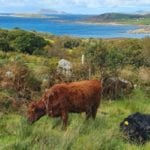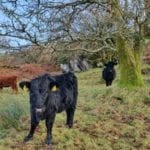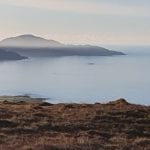Eoghan Daltun
Eoghan Daltun runs a high nature value (HNV) farm and rewilding project on the Beara peninsula of Co. Cork. “The farm is all about productivity of biodiversity and nature. That is the primary aim. We need nature. Ecosystems are what make everything work - from the air that we breathe, to a stable climate, to clean water.”
Three different types of land make up the farm. The main block of private land is 21.5 acres, the majority of which is highly species-rich native Atlantic temperate rainforest. This area has been fully given over to nature and Eoghan has taken immense pride in watching this unique ecosystem retore and regenerate itself naturally. “The native woodland is incredibly species rich, this part of Ireland is recognized by biologists as a ‘biodiversity hotspot’ in terms of bryophytes (mosses and liverworts)”. The woodland consists of old sessile oaks and range of other wild native tree species. The understory is equally as species-rich and diverse, consisting of a vast array of wildflowers, ferns, mosses, lichen and fungi. The farm is home to an array of wildlife, including some rare species like the Lesser Horseshoe Bat, the Marsh Fritillary Butterfly and the Kerry Slug.
The next block of land is 11.5 acres, about 1/3 of which is also native woodland and the remainder is natual species-rich grassland. The final block of land is commonage. Previously a sheep farmer, Eoghan has recently replaced his flock of sheep with a small herd of Dexter cattle. He believes the cattle, as they are non-selective grazers, are better suited to his HNV farming practice and to the regeneration of the land. The plan is to graze the cattle on the commonage during the summer months and then bring them back to the lower lands during the winter – emulating the very old practice of ‘booleying’ which involved moving animals to the uplands during the summer season. Eoghan believes we need to expand our definition of a farmer beyond solely a producer of food for humans - “We can’t just view land as a resource to produce food for humans to eat. We have to see the land as something that produces all sorts of other things that we need, including functional ecosystems.”
Nomination Description 1:
Eoghan Daltun has a small farm of 73 acres (including 40 acres of mountain commonage) overlooking the Atlantic near Eyeries on the Beara Peninsula, West Cork. For the last 12 years he has been rewilding 21.5 acres of his own ground, giving this area entirely over to nature, mostly in the form of highly species-rich native Atlantic temperate rainforest.
Previously a sheep farmer, he now farms the rest of the land in an extremely high nature value (HNV) way with the local breed of cattle, Dexters, which arrived last summer. They spend much of the warmer months on the mountain commonage, and are brought down for the winter when the many naturally regenerating wild native trees such as oak have dropped their leaves, and are therefore left undamaged by the grazing. In effect, it is not unlike the age-old traditional practice known as ‘booleying’. As cattle graze and browse far less selectively than sheep, in the low densities Eoghan keeps them a very rich diversity of wild native flora has been able to develop, which has in turn been hugely beneficial for insects, birds, and other native fauna.
Here he describes the woodland on his farm “a 32-acre tangle of old Sessile Oak and over a dozen other wild native tree species, all dripping with epiphytes (plants growing on trees, one of the defining characteristics of rainforest anywhere in the world). The ground flora is also particularly rich and, with a riot of different species of flowers, ferns, fungi, mosses, and lichens, the botanical diversity here is as high as you’ll find anywhere on the island of Ireland. Indeed, in terms of its bryophytes (mosses & liverworts), the southwest of Ireland is considered by many experts to be something of a global biodiversity ‘hotspot’,”
More than fifty species of birds either live in or can be seen in and around his farm including on occasion the White-tailed Sea Eagle. Other rare and protected species found on the farm include Marsh Fritillary Butterfly, Kerry Slug and Killarney Fern (all three of the translucent filmy ferns native to Ireland are present on the farm).
He keeps his Dexter cattle in a low intensity way dosing rarely, only when necessary.
Eoghan through his website and on twitter promotes field trips and walks on the farm where visitors can appreciate the rich biodiversity of a mountain farm managed sensitively to protect and enhance the rich biodiversity present.
Eoghans farm represents a model about how we could develop new models of farming are uplands and native woodlands, all connected together in an ecological interplay of nature, wildness and traditional farming which helps both landscape and human society.
Nominator: Gerard Walshe FFN Ambassador
Nomination 2:
Eoghan is a farmer like no other we have encountered. He has a keen sense of his place on the land but, not only that, he place on the planet. He sees the connections between himself and his family, the animals he keeps, the land he tends and the crises we face in the collapse of biodiversity and our climate system. His holding includes an area of native Atlantic rainforest as well as a share in a commonage that he farms with sheep and Dexter cattle. His approach to his land includes rewilding in recognition that we must allow space for nature which is not farmed, as well as farming using low numbers of animals which are sensitive to the vegetation. He has shown that this patch of land, which had few trees on it when he first took ownership, and which overlooks the Atlantic Ocean in a landscape that is not associated with trees or woodlands, is not only capable of supporting trees, but can bring the full diversity of life back to the land in a remarkably short space of time. He facilitates school tours so that local children can reconnect with Irish nature in a way that recognises the past while also imagining the future. His animals are out over winter and graze the land in such a way that allow trees to naturally regenerate - showing how grazing animals and trees are not only perfectly compatible but can sustain each other. Through the use of social media (twitter @irishrainforest), Eoghan is challenging accepted ways of thinking about land that is normally seen as 'poor' or 'marginal' when in fact it is rich and central to how people can live and work in this area. He firmly believes that 'wild nature' has a place in Ireland and his work shows that this doesn't mean turning our back on our farming heritage. He is a native of Dublin and so his story is the reverse of the one we typically hear about migration from these areas to the cities. He lives in this place because it allows him to live with his family where he feels his connection to nature on a daily basis. Eoghan's story is truly an inspiration to anyone who feels that we're destined for a future of rural decline and ecological degradation. We heartily recommend Eoghan for this award!
Nominator: Padraic Fogarty, Campaign Officer, Irish Wildlife Trust




